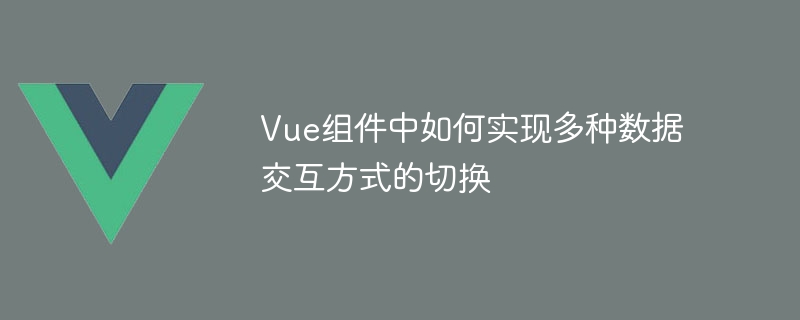Vue元件中如何實作多種資料互動方式的切換

Vue元件中如何實作多種資料互動方式的切換
在Vue元件開發中,常常會遇到需要切換不同的資料互動方式的場景,例如透過API請求資料、透過表單輸入資料或透過WebSocket即時推送資料等等。本文將介紹如何在Vue元件中實現這種多種資料互動方式的切換,並且會提供具體的程式碼範例。
方式一:API請求資料
在某些情況下,我們需要透過API請求資料來取得後台的資料。以下是使用axios函式庫發送API請求的範例:
<template>
<div>
<ul>
<li v-for="item in items" :key="item.id">{{ item.name }}</li>
</ul>
<button @click="fetchData">Fetch Data</button>
</div>
</template>
<script>
import axios from 'axios';
export default {
data() {
return {
items: [],
};
},
methods: {
fetchData() {
axios.get('/api/data')
.then((response) => {
this.items = response.data;
})
.catch((error) => {
console.log(error);
});
},
},
};
</script>上面的範例中,當點擊"Fetch Data"按鈕時,會傳送一個GET請求到後台的/api/data接口,並將返回的資料渲染到頁面中。
方式二:表單輸入資料
在使用者需要填寫表單的情況下,我們可以透過監聽表單輸入事件來取得使用者輸入的資料。下面是一個簡單的表單輸入範例:
<template>
<div>
<form @submit.prevent="handleSubmit">
<input type="text" v-model="username" placeholder="Username" />
<input type="password" v-model="password" placeholder="Password" />
<button type="submit">Login</button>
</form>
<p>{{ message }}</p>
</div>
</template>
<script>
export default {
data() {
return {
username: '',
password: '',
message: '',
};
},
methods: {
handleSubmit() {
// 处理表单提交逻辑
// 可以将用户输入的数据发送到后台,或者进行其他操作
this.message = `Welcome, ${this.username}!`;
this.username = '';
this.password = '';
},
},
};
</script>上面的範例中,當使用者輸入使用者名稱和密碼,並點擊"Login"按鈕時,會觸發表單的提交事件handleSubmit。在handleSubmit方法中,我們可以對表單的資料進行處理,例如將使用者名稱顯示在頁面上,並清空輸入框中的資料。
方式三:WebSocket即時推送數據
如果需要即時推送數據,我們可以使用WebSocket來建立與伺服器的長連接,並透過WebSocket接收伺服器推送的數據。以下是使用Vue-WebSocket庫來建立WebSocket連接的範例:
<template>
<div>
<ul>
<li v-for="message in messages" :key="message.id">{{ message.content }}</li>
</ul>
</div>
</template>
<script>
import VueWebSocket from 'vue-websocket';
export default {
mixins: [VueWebSocket('ws://localhost:8080/ws')],
data() {
return {
messages: [],
};
},
methods: {
onMessage(event) {
// 处理接收到的推送消息
this.messages.push(JSON.parse(event.data));
},
},
};
</script>上面的範例中,透過Vue-WebSocket庫建立了一個WebSocket連接,連接的URL為ws://localhost:8080/ws。在onMessage方法中處理接收到的推播訊息,並將其渲染到頁面中。
方式切換
在Vue元件中實作多種資料互動方式的切換,我們可以利用Vue的條件渲染功能,根據不同的狀態來顯示不同的資料互動方式。下面是一個簡單的切換範例:
<template>
<div>
<div v-show="mode === 'api'">
<!-- API请求方式 -->
<ul>
<li v-for="item in items" :key="item.id">{{ item.name }}</li>
</ul>
<button @click="fetchData">Fetch Data</button>
</div>
<div v-show="mode === 'form'">
<!-- 表单输入方式 -->
<form @submit.prevent="handleSubmit">
<input type="text" v-model="username" placeholder="Username" />
<input type="password" v-model="password" placeholder="Password" />
<button type="submit">Login</button>
</form>
<p>{{ message }}</p>
</div>
<div v-show="mode === 'websocket'">
<!-- WebSocket方式 -->
<ul>
<li v-for="message in messages" :key="message.id">{{ message.content }}</li>
</ul>
</div>
<div>
<!-- 切换按钮 -->
<button @click="switchMode('api')">API</button>
<button @click="switchMode('form')">Form</button>
<button @click="switchMode('websocket')">WebSocket</button>
</div>
</div>
</template>
<script>
import axios from 'axios';
import VueWebSocket from 'vue-websocket';
export default {
mixins: [VueWebSocket('ws://localhost:8080/ws')],
data() {
return {
mode: 'api',
items: [],
username: '',
password: '',
message: '',
messages: [],
};
},
methods: {
fetchData() {
axios.get('/api/data')
.then((response) => {
this.items = response.data;
})
.catch((error) => {
console.log(error);
});
},
handleSubmit() {
// 处理表单提交逻辑
// 可以将用户输入的数据发送到后台,或者进行其他操作
this.message = `Welcome, ${this.username}!`;
this.username = '';
this.password = '';
},
onMessage(event) {
// 处理接收到的推送消息
this.messages.push(JSON.parse(event.data));
},
switchMode(mode) {
// 切换数据交互方式
this.mode = mode;
},
},
};
</script>上面的範例中,我們透過v-show指令根據不同的mode值來決定顯示哪種資料交互方式的內容。透過點擊不同的按鈕來切換mode的值,從而達到切換資料互動方式的效果。
總結
以上就是在Vue元件中實作多種資料互動方式的切換的方法。透過合理使用Vue的條件渲染功能,結合對應的程式碼範例,我們可以在開發過程中靈活切換不同的資料互動方式,以適應不同的業務需求。同時,這種方式也有助於提高程式碼的可維護性和可擴充性。希望這篇文章對你有幫助,謝謝閱讀。
以上是Vue元件中如何實作多種資料互動方式的切換的詳細內容。更多資訊請關注PHP中文網其他相關文章!

熱AI工具

Undresser.AI Undress
人工智慧驅動的應用程序,用於創建逼真的裸體照片

AI Clothes Remover
用於從照片中去除衣服的線上人工智慧工具。

Undress AI Tool
免費脫衣圖片

Clothoff.io
AI脫衣器

Video Face Swap
使用我們完全免費的人工智慧換臉工具,輕鬆在任何影片中換臉!

熱門文章

熱工具

記事本++7.3.1
好用且免費的程式碼編輯器

SublimeText3漢化版
中文版,非常好用

禪工作室 13.0.1
強大的PHP整合開發環境

Dreamweaver CS6
視覺化網頁開發工具

SublimeText3 Mac版
神級程式碼編輯軟體(SublimeText3)
 win11家庭版切換專業版操作教學_win11家庭版切換專業版操作教學
Mar 20, 2024 pm 01:58 PM
win11家庭版切換專業版操作教學_win11家庭版切換專業版操作教學
Mar 20, 2024 pm 01:58 PM
Win11家庭版怎麼轉換成Win11專業版?在Win11系統中,分為了家庭版、專業版、企業版等,而大部分Win11筆電都是預先安裝Win11家用版系統。而今天小編就帶給大家win11家庭版切換專業版操作步驟!1、先在win11桌面此電腦上右鍵屬性。 2、點選更改產品金鑰或升級windows。 3、然後進入後點選更改產品金鑰。 4.再輸入啟動金鑰:8G7XN-V7YWC-W8RPC-V73KB-YWRDB,選擇下一步。 5.接著就會提示成功,這樣就可以將win11家用版升級win11專業版了。
 小米14Ultra如何切換4g和5g?
Feb 23, 2024 am 11:49 AM
小米14Ultra如何切換4g和5g?
Feb 23, 2024 am 11:49 AM
小米14Ultra是今年小米中非常火熱的機型之一,小米14Ultra不僅升級了處理器以及各種配置,而且還為用戶們帶來了很多新的功能應用,從小米14Ultra銷售就可以看出來手機的火爆程度,不過有一些常用的功能可能你還沒了解。那麼小米14Ultra如何切換4g和5g呢?下面小編就來為大家介紹一下具體的內容吧!小米14Ultra怎麼換4g和5g? 1.打開手機的設定選單。 2、設定選單中尋找並選擇「網路」、「行動網路」的選項。 3.在行動網路設定中,會看到「首選網路類型」選項。 4、點選或選擇該選項,會看到
 Win10系統如何實現雙系統切換
Jan 03, 2024 pm 05:41 PM
Win10系統如何實現雙系統切換
Jan 03, 2024 pm 05:41 PM
很多朋友剛接觸win系統的時候可能用不習慣,電腦裡存雙系統,這時候其實是可以雙系統切換的,下面就一起來看看兩個系統切換的詳細步驟吧。 win10系統如何兩個系統切換方法一、快捷鍵切換1、按下“win”+“R”鍵開啟運行2、在運行框中輸入“msconfig”點擊“確定”3、在打開的“系統配置”介面中選擇自己需要的系統點擊“設為預設值”,完成後“重新啟動”即可完成切換方法二、開機時選擇切換1、擁有雙系統時開機會出現一個選擇操作介面,可以使用鍵盤“上下”鍵進行選擇系統
 切換蘋果電腦雙系統啟動方式
Feb 19, 2024 pm 06:50 PM
切換蘋果電腦雙系統啟動方式
Feb 19, 2024 pm 06:50 PM
蘋果雙系統開機怎麼切換蘋果電腦作為一款功能強大的設備,除了搭載自家的macOS作業系統外,也可以選擇安裝其他作業系統,例如Windows,從而實現雙系統的切換。那麼在開機時,我們要如何切換這兩個系統呢?本文就來為大家介紹一下在蘋果電腦上如何實現雙系統的切換。首先,在安裝雙系統之前,我們需要確認自己的蘋果電腦是否支援雙系統切換。一般來說,蘋果電腦都是基於
 excel切換工作簿快速鍵的使用方法
Mar 20, 2024 pm 01:50 PM
excel切換工作簿快速鍵的使用方法
Mar 20, 2024 pm 01:50 PM
在excel軟體的應用程式裡,我們已經習慣使用快捷鍵,讓有些操作變得更簡單和快捷,excel的多個表格之間有時候會有相關的數據,我們在查看時,要不停的切換工作簿,如果有更快捷的切換方法,就會省下很多切換浪費的時間,對工作效率的提高有很大的幫助,什麼辦法可以完成快速的切換呢,針對這個問題,小編今天要講的內容是:excel切換工作簿快速鍵的使用方法。 1.首先在開啟的excel表格的下方可以看到有多個工作簿,需要快速切換不同的工作簿,如下圖所示。 2、然後按下鍵盤上的Ctrl鍵不動,如果需要向右選擇工作
 認識全角與半角:切換技巧一覽
Mar 25, 2024 pm 01:36 PM
認識全角與半角:切換技巧一覽
Mar 25, 2024 pm 01:36 PM
在日常生活中,我們經常會遇到全角和半角的問題,但可能很少有人深入了解它們的意義和差異。全角和半角,其實是一種字元編碼方式的概念,而在電腦輸入、編輯、排版等方面都有其特殊的應用。本文將深入探討全角和半角的差異、切換技巧以及在實際生活中的應用。首先,全角和半角在漢字文字領域中的定義是:一個全角字元佔用一個字元位置,而一個半角字元佔用半個字元位置。在計算機中,通
 無法使用win11的alt+tab切換介面,出現的原因是什麼?
Jan 02, 2024 am 08:35 AM
無法使用win11的alt+tab切換介面,出現的原因是什麼?
Jan 02, 2024 am 08:35 AM
win11支援使用者使用alt+tab快捷鍵的方式來調出桌面切換工具,但是最近有朋友遇到了win11alt+tab切換不了介面的問題,不知道是什麼原因也不知道怎麼解決。 win11alt+tab切換不了介面什麼原因:答:因為快捷鍵功能被停用了,以下是解決方法:1、首先我們按下鍵盤「win+r」開啟運作。 2、接著輸入「regedit」並回車打開群組原則。 3.然後進入“HKEY_CURRENT_USER\SOFTWARE\Microsoft\Windows\CurrentVersion\Explorer”
 如何在華為手機上切換雙系統設定
Feb 20, 2024 am 10:09 AM
如何在華為手機上切換雙系統設定
Feb 20, 2024 am 10:09 AM
隨著智慧型手機的迅速發展,華為作為一家領先的科技公司,推出了許多備受歡迎的手機產品。其中,華為雙系統是一項讓許多用戶感到興奮的功能。透過華為雙系統,使用者可以在同一台手機上同時運行兩個作業系統,例如Android和HarmonyOS。這個功能可以帶來更大的靈活性和便利性。那麼,華為雙系統如何切換設定?讓我們來一起了解一下。首先,在華為手機上切換到雙系統設定之前,






